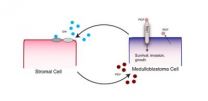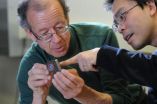(Press-News.org) A multi-institutional team led by Massachusetts General Hospital (MGH) researchers has identified a molecular pathway that appears to be essential for the growth and spread of medulloblastoma, the most common malignant brain tumor in children. In their report in the Feb. 28 issue of Cell, they show that blocking this pathway – which involves interactions between tumor cells and the surrounding tissues – leads to regression of all four molecular subtypes of medulloblastoma in several mouse models.
"Our finding that a pathway carrying signals from host cells to tumor cells via placental growth factor and its receptor neuropilin 1 is critical to the growth of medulloblastoma, regardless of molecular subtype, strongly supports evaluating antibodies against these proteins as a novel therapeutic approach to this pediatric cancer," says Rakesh K. Jain, PhD, director of the Steele Laboratory for Tumor Biology at MGH and corresponding author of the study.
A highly malignant tumor that originates in the cerebellum, medulloblastoma accounts for about 20 percent of all pediatric brain tumors and is ten times more common in children than in adults. While aggressive treatment with surgery, chemotherapy and radiation significantly improves patient survival, those treatments can have long-term developmental, behavioral, and neurological side effects, particularly in the youngest patients, making the need for less damaging therapies essential.
Impetus for the current investigation began with studies by Peter Carmeliet, MD, PhD, of the Vesalius Research Center in Belgium, a co-author of the current study. Carmeliet found that an antibody against placental growth factor (PlGF) could block angiogenesis in a number of adult tumors. Since PlGF, unlike other angiogenic proteins, is not required for normal postnatal development, Jain and his Steele Lab colleague Lei Xu, MD, PhD, proposed targeting PlGF as anti-angiogenic treatment for pediatric tumors. Matija Snuderl, MD, of the Steele Lab, a co-lead author of the current study, then found that PlGF was highly expressed in all types of medulloblastoma. Other members of Jain's team found that high expression of the P1GF receptor neuropilin 1 (Nrp1) was associated with poor survival in medulloblastoma patients.
To investigate mechanisms behind the potential role of PlGF in medulloblastoma, the MGH investigators collaborated with colleagues in the U.S., Belgium, Canada and Germany. They first confirmed that PlGF is expressed in patient samples of all subtypes of medulloblastoma and that expression of Nrp1 was more significant than that of PlGF's more common receptor, VEGFR1. Experiments in several mouse models revealed that the presence of PlGF is essential for the progression of medulloblastoma and that treatment with several antibodies against the growth factor reduced tumor growth and spread, increasing animal survival even without substantially inhibiting angiogenesis
The researchers were surprised to find that most PlGF was produced by surrounding supportive tissue called stroma and not by the tumor cells. Further investigation revealed that release of the developmental protein Shh (sonic hedgehog) by tumor cells induces expression in nearby stromal cells of PlGF, which then binds to the Nrp1 receptor on tumor cells, leading to further tumor growth. The authors note that therapies that block the interaction between PlGF and Nrp1 are less likely to lead to treatment resistance than are therapies directly targeting mutations that drive tumor growth.
"The importance of tumor-stromal interactions has been recognized for decades, especially the formation of new blood vessels to supply tumors," says Jain, the Cook Professor of Radiation Oncology (Tumor Biology) at Harvard Medical School. "Our discovery of an entirely different way that tumor-stromal interactions drive cancer progression supports the exciting possibility that targeting that pathway in medulloblastoma could be more broadly effective with fewer side effects for patients. Antibodies against both PlGF and Nrp1 have been developed and tested in adult patients. There is hope that they could be safe in pediatric patients, but that needs to be established in clinical trials."
INFORMATION:
In addition to Snuderl, co-lead authors of the Cell article are Ana Batista, PhD, and Nathaniel D. Kirkpatrick, PhD, of the Steele Lab, and Carmen Ruiz de Almodovar, PhD, of the Vesalius Research Center. Collaborating institutions include Children's Hospital Boston, the Vesalius Research Center, University of Leuven, Belgium; Genentech, Inc.; the University of British Columbia; and University Hospital, Münster, Germany. Support for this study includes a grant from Hoffmann-La Roche and National Institutes of Health grant R01CA163815. Carmeliet has patent applications for intellectual property related to this study, and Jain is on the boards of trustees of H&Q Healthcare Investors and H&Q Life Science Investors.
Massachusetts General Hospital, founded in 1811, is the original and largest teaching hospital of Harvard Medical School. The MGH conducts the largest hospital-based research program in the United States, with an annual research budget of more than $775 million and major research centers in AIDS, cardiovascular research, cancer, computational and integrative biology, cutaneous biology, human genetics, medical imaging, neurodegenerative disorders, regenerative medicine, reproductive biology, systems biology, transplantation biology and photomedicine. In July 2012, MGH moved into the number one spot on the 2012-13 U.S. News & World Report list of "America's Best Hospitals."
Study identifies growth factor essential to the most common malignant pediatric brain tumor
Interaction between signaling protein and receptor could be attractive treatment target
2013-02-28
ELSE PRESS RELEASES FROM THIS DATE:
How did early primordial cells evolve?
2013-02-28
VIDEO:
L-form bacteria undergoes cell division. The time scale is in minutes.
Click here for more information.
Four billion years ago, soon after the planet cooled enough for life to begin, primordial cells may have replicated and divided without protein machinery or cell walls, relying instead on just a flimsy lipid membrane. New research on bacteria examines exactly how these primitive cells could have evolved without such crucial structures. While the vast majority of bacteria ...
Animas' development of a first-generation closed loop insulin delivery system progresses
2013-02-28
WEST CHESTER, Pa., February 28, 2013 – Animas Corporation announced today positive results from the second phase of human clinical trials of a first-generation, closed-loop insulin delivery system in development, designed to predict a rise or fall in blood glucose and correspondingly increase, decrease, suspend and resume insulin delivery. The data were presented at the Advanced Technologies & Treatments for Diabetes (ATTD) Conference in Paris, France.
The feasibility study of the predictive Hypoglycemia-Hyperglycemia Minimizer (HHM) System* in development was conducted ...
The birth of a giant planet?
2013-02-28
An international team led by Sascha Quanz (ETH Zurich, Switzerland) has studied the disc of gas and dust that surrounds the young star HD 100546, a relatively nearby neighbour located 335 light-years from Earth. They were surprised to find what seems to be a planet in the process of being formed, still embedded in the disc of material around the young star. The candidate planet would be a gas giant similar to Jupiter.
"So far, planet formation has mostly been a topic tackled by computer simulations," says Sascha Quanz. "If our discovery is indeed a forming planet, then ...
Secondary facelift achieves good results, reports plastic and reconstructive surgery
2013-02-28
Philadelphia, Pa. (February 28, 2013) – Performed an average of a decade after initial facelift surgery, a "secondary" facelift can achieve similarly lasting results with a low complication rate, according to a paper in the March issue of Plastic and Reconstructive Surgery®, the official medical journal of the American Society of Plastic Surgeons (ASPS).
Dr. Rod J. Rohrich and colleagues of University of Southwestern Medical Center, Dallas, report their 20-year experience with secondary facelift surgery, or "rhytidectomy." The researchers conclude that, with attention ...
Round or 'shaped,' implants yield good results in breast reconstruction
2013-02-28
Philadelphia, Pa. (February 28, 2013) –For women undergoing breast reconstruction using implants, most patient-reported outcomes are similar with two different shapes of silicone gel-filled implants, reports a study in the March issue of Plastic and Reconstructive Surgery®, the official medical journal of the American Society of Plastic Surgeons (ASPS).
Assessment of key areas of quality of life after breast reconstruction shows few significant differences with conventional round implants versus newer "shaped" implants, according to the new research, led by Dr. Sheina ...
Progesterone may be why pregnant women are more vulnerable to certain infections
2013-02-28
Bethesda, MD—Women who are pregnant or using synthetic progesterone birth control injections have a conspicuous vulnerability to certain infections including malaria, Listeria, HIV, and herpes simplex virus. A new research report appearing in the March 2013 issue of the Journal of Leukocyte Biology offers strong evidence for a possible explanation: the progesterone receptor, a pregnancy hormone sensor, targets a part of the immune system responsible for protection against these and other invaders. In addition to helping explain why some women are more vulnerable to certain ...
Brown unveils novel wireless brain sensor
2013-02-28
PROVIDENCE, R.I. [Brown University] — A team of neuroengineers based at Brown University has developed a fully implantable and rechargeable wireless brain sensor capable of relaying real-time broadband signals from up to 100 neurons in freely moving subjects. Several copies of the novel low-power device, described in the Journal of Neural Engineering, have been performing well in animal models for more than year, a first in the brain-computer interface field. Brain-computer interfaces coud help people with severe paralysis control devces with their thoughts.
Arto Nurmikko, ...
Brain-to-brain interface allows transmission of tactile and motor information between rats
2013-02-28
DURHAM, N.C. -- Researchers have electronically linked the brains of pairs of rats for the first time, enabling them to communicate directly to solve simple behavioral puzzles. A further test of this work successfully linked the brains of two animals thousands of miles apart—one in Durham, N.C., and one in Natal, Brazil.
The results of these projects suggest the future potential for linking multiple brains to form what the research team is calling an "organic computer," which could allow sharing of motor and sensory information among groups of animals. The study was published ...
Replacing soybean meal in pig diets
2013-02-28
Canola, cottonseed, and sunflower products can replace soybean meal in diets fed to pigs, but they contain less protein and energy. To determine if it makes economic sense to use them, producers need to know the concentrations and digestibility of the nutrients they contain. To help them make the decision, University of Illinois researchers examined amino acid digestibility for these products.
"Soybean is by far the biggest oilseed crop in the world," said Hans Stein, professor of animal sciences. "But canola, cottonseed, and sunflowers are grown in areas where soybeans ...
After the human genome project: The human microbiome project
2013-02-28
Bethesda, MD—Earth Day may be more than a month away, but another, more personal, ecosystem has been shown to also be worth protecting—within our bodies are communities of microbes that affect the behavior of human cells hosting them. These communities, called the "microbiome," are so crucial to our health that some consider it to be a complex "second genome." Understanding the interaction of these microbes among one another and their human hosts has the potential to yield insights into numerous diseases and complex human disorders from obesity to susceptibility to infection. ...
LAST 30 PRESS RELEASES:
University of Oklahoma researcher awarded funding to pursue AI-powered material design
Exploring how the visual system recovers following injury
Support for parents with infants at pediatric check-ups leads to better reading and math skills in elementary school
Kids’ behavioral health is a growing share of family health costs
Day & night: Cancer disrupts the brain’s natural rhythm
COVID-19 vaccination significantly reduces risk to pregnant women and baby
The role of vaccination in maternal and perinatal outcomes associated with COVID-19 in pregnancy
Mayo Clinic smartwatch system helps parents shorten and defuse children's severe tantrums early
Behavioral health spending spikes to 40% of all children’s health expenditures, nearly doubling in a decade
Digital cognitive behavioral treatment for generalized anxiety disorder
Expenditures for pediatric behavioral health care over time and estimated family financial burden
Air conditioning in nursing homes and mortality during extreme heat
The Alps to lose a record number of glaciers in the next decade
What makes a good proton conductor?
New science reporting guide published for journalists in Bulgaria
New international study reveals major survival gaps among children with cancer
New science reporting guide published for journalists in Turkey
Scientists develop a smarter mRNA therapy that knows which cells to target
Neuroanatomy-informed brain–machine hybrid intelligence for robust acoustic target detection
Eight SwRI hydrogen projects funded by ENERGYWERX
The Lundquist Institute and its start-up company Vitalex Biosciences Announces Strategic Advancement of Second-Generation fungal Vaccine VXV-01 through Phase 1 Trials under $40 Million Competitive Con
Fine particles in pollution are associated with early signs of autoimmune disease
Review article | Towards a Global Ground-Based Earth Observatory (GGBEO): Leveraging existing systems and networks
Penn and UMich create world’s smallest programmable, autonomous robots
Cleveland researchers launch first major study to address ‘hidden performance killer’ in athletes
To connect across politics, try saying what you oppose
Modulating key interaction prevents virus from entering cells
Project explores barriers to NHS career progression facing international medical graduates
Jeonbuk National University researchers explore the impact of different seasonings on the flavor perception of Doenjang soup
Two Keck Medicine of USC Hospitals named Leapfrog Top Teaching Hospitals
[Press-News.org] Study identifies growth factor essential to the most common malignant pediatric brain tumorInteraction between signaling protein and receptor could be attractive treatment target



